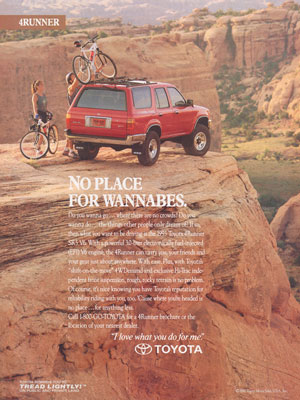Around 2001, Christopher Schaberg noticed that The New Yorker magazine – that bastion of hip, cosmopolitan literary culture – frequently carried car ads depicting romantic mountain landscapes. This struck him as an odd juxtaposition, not just between the urbanity of The New Yorker and the wilderness of Suburu, Lincoln Aviator, and Chevy Blazer ads, but between the latter and our ordinary, day-to-day experience of SUVs. At the same time, he noticed parallels between these car ads and the themes of American nature writers he was studying, writers such as Gary Snyder, Annie Proulx, Gretel Ehrlich and Terry Tempest Williams.

These observations ended up yielding a Master’s thesis, which, eventually, led to a career in English Literature, Cultural Studies and Environmental Humanities. (Schaberg is now Dorothy Harrell Brown Distinguished Professor of English at Loyola University. Among other things, he’s written three books on airports and airplane travel. For more his work and publications, see here.)
More recently, my husband Dave and our 12-year-old son Reggie have been watching the odd football game on the weekend. They also have been wondering what’s up with these commercials that equate driving an SUV with a deep dive into nature.
There’s one commercial for the Chevy Trailblazer that they find paricularly hilarious. It opens with a view from the sky of a single road cutting through a forest, followed by a similar road in a desert landscape. Cut to two friends in the Trailblazer. One asks “here?” to which his friend responds, “Nah.” And so it goes. “Here?” “No.” Until they arrive deep in the woods (or on a beach), at which point the commercial splices together scenes of mountain biking, scuba diving and rock climbing, announcing “when the middle of nowhere is somewhere.”
Ah, it’s so tempting to unstitch that caption! Nowhere/ Somewhere? I suppose it’s the mountain biking, scuba diving and rock climbing that transforms the Nowhere into a Somewhere. Or is it the Chevy Trailblazer itself? So many questions.
But I’ll hold back, because I think you’ll find more interesting analysis in my conversation with Chris Schaberg.
I had a lot of fun with this one. I hope you’ll enjoy it too!
A few notes. The Baobab Car is actually by Arnauld Laval and Jaqueline Held, not to be confused with Timothy’s Dream Book by Pierre Le-Tan.
Here is an article on the history of car advertising I found helpful, where you can see the Pontiac ad with the tiger skin.
Here’s the Joe Biden commercial we talk about; the “tiger under the hood” commercial from 1965; the Toyota Rav 4 commercial, “Chase the Unknown”; Ford Bronco’s “Built Wild”; Lincoln Aviator’s “Warm Escape” commercial with Matthew McConaughey; and the Jeep Wrangler 4xe commercial, “Pale Blue Dot.”

I could not recommend this podcast with any greater enthusiasm than I do. It is not just about advertising, (although that “just” is perhaps irrelevant in the new age where we are all essentially advertising even ourselves every minute of the day )This discussion explores just how deep and complex is the relationship in American culture and thought to both cars and nature as well as cars in the context of nature. The mind is encouraged to think in new ways. And it’s also fun. Not heavy, even if the topic is, but fun. A dynamic discussion infused with humor as well as serious thought.
I’m torn because I agree with you on a macro level – most of those vehicles sold with this type of advertising are unnecessary fuel-guzzlers that never put a tire off of pristine pavement and increase fossil fuel emissions. But on the other hand I have a Jeep and we get out a lot more than we did before it. Including going places we wouldn’t camp or hike at with 3 small kids if we had to backpack it in. (No offense to those who can) …
I’m glad to hear that you’re getting your kids out in the wilderness. These things are never black and white are they?